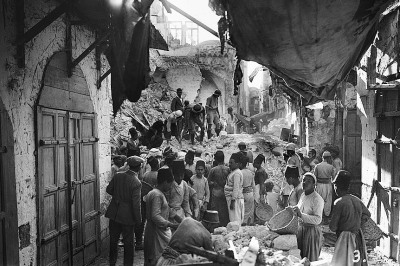Pages in Section 3

1926-27 Drought, Floods and Earthquakes
i. Mandate becomes Official
ii. Reformation of the Port Police
iii. 1926 Disbandment of the British Gendarmerie
iv. The Transjordon Frontier Force
v. The Bedouin Police Units
vi. At Ground Level in 1920s Gaza
vii.1926-27 Drought, Floods and Earthquakes
viii. Police and the Western Wall
For two years following the reformation of the British and Palestinian sections of the Palestine Police, weather and natural disasters rather than riots disrupted daily life in Palestine. The winter of 1925-26 saw the lowest recorded rainfall over Jerusalem. Combined with the recent huge increase in the population the drought caused Solomon's Pools, Jerusalem's chief reservoir, to run dry by early summer. The rainwater cisterns beneath houses were all empty.
The government requisitioned the spring water of a local Arab village renowned for its market gardens. bankrupting the villagers while still allowing Jewish construction workers all the water they needed to mix concrete for the many new Jewish immigrants. The Arab market gardeners whose water had been taken went bankrupt and in the old city Even with the requisition of water residents in the old city had to queue for hours to fetch water from the public taps during the limited hours they were turned on. The Police prepared for riots but the Arabs, this time, preferred to fight their battles in the courts rather than on the ground.
The Negev too was badly hit and the Bedouin there moved their herds to Northern Palestine where they came into conflict with the new Jewish agricultural settlements. The police took too long to come to the aid of settlers. They relied on their own Watchmen.
The next winter (1926-1927) was completely different from its predecessor. The first rains arriving in Haifa, Jaffa and Jerusalem on October 5th. Severe storms in November struck Jaffa hardest causing sailors on anchored ships t to be swept overboard and drowned and other steamers to by pass Jaffa and head for Haifa which too suffered storm damage. By the middle of December, cisterns in Jerusalem were halfway full, and still it did not stop raining.
Storms struck again in February. A steamer. The Lord Byron, was blown inshore at Jaffa and remained grounded for many days. Several members British section of Police received official commendations for keeping in contact with the crew while it was stranded.
Much of Palestine, from Jerusalem northwards was blanketed in snow for four days
In May a spell of extraordinary hot weather was followed by a return to wintry conditions.
 Haifa suffered a minor earthquake in March but on 11th. July, 1927 a severe earthquake occurred.
The village of Renah in Galilee was completely obliterated. Many fine buildings in Jerusalem, including the Basilica of the Holy Sepulchre, were damaged but Nablus was worst hit,(See photo on right) hastening its decline. Haifa, a centre for a large number of Jewish settlements, overtook it in importance.
The Police who carried out rescue work during this catastrophe received much praise for their efforts.
Haifa suffered a minor earthquake in March but on 11th. July, 1927 a severe earthquake occurred.
The village of Renah in Galilee was completely obliterated. Many fine buildings in Jerusalem, including the Basilica of the Holy Sepulchre, were damaged but Nablus was worst hit,(See photo on right) hastening its decline. Haifa, a centre for a large number of Jewish settlements, overtook it in importance.
The Police who carried out rescue work during this catastrophe received much praise for their efforts.